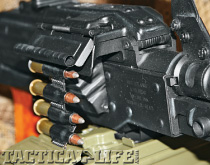Designed by Mikail T. Kalashnikov, the Pulemet Kalashnikova (machine-gun, Kalashnikov), or PK, as it was initially called, was standardized during the early 1960s by the USSR for the Soviet military. Like virtually every other Soviet general-purpose machine (GPM) gun since World War II, the PK was chambered for the 7.62x54Rmm cartridge.
 This cartridge was adopted in 1891 with the Mosin-Nagant bolt action rifle of the same year, and its 150-grain spitzer bullet was adopted in 1909. Typical of bottlenecked rifle cartridges of its day, the 7.62x54Rmm has a tapered case with a rimmed head and a muzzle velocity of about 2800 fps (feet per second). Over the years it has proven very accurate in competition, as well as being effective on the battlefield where it compares with the .30-06 and 7.62x51mm NATO cartridges.
This cartridge was adopted in 1891 with the Mosin-Nagant bolt action rifle of the same year, and its 150-grain spitzer bullet was adopted in 1909. Typical of bottlenecked rifle cartridges of its day, the 7.62x54Rmm has a tapered case with a rimmed head and a muzzle velocity of about 2800 fps (feet per second). Over the years it has proven very accurate in competition, as well as being effective on the battlefield where it compares with the .30-06 and 7.62x51mm NATO cartridges.
Like almost all gas piston operated GPM guns and light machine-guns (LMGs), the PK fires from the open bolt position, and is of long stroke gas piston operation. This means that the piston travels at least the length of the cartridge and is attached to or part of the operating rod, slide or bolt carrier. Locking is via a two-lug rotating bolt that’s very similar to the AK family of rifles. Differing from the AK, the firing pin is attached to the bolt carrier and automatically moves forward to fire the cartridge after the bolt locks into battery.
Advertisement — Continue Reading Below
























